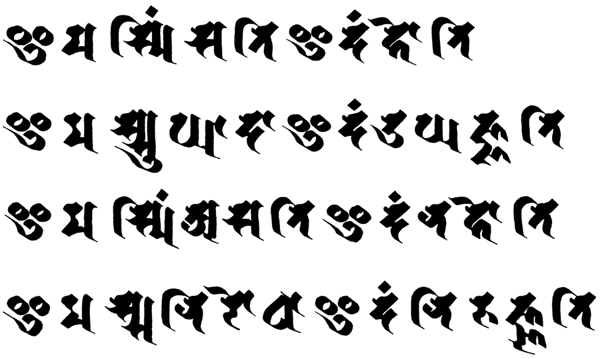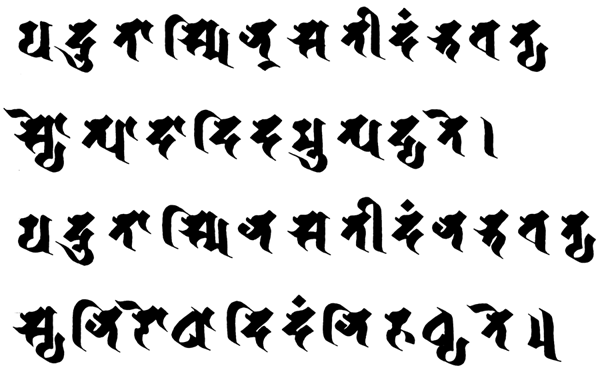These lines are of the most famous explanantions of the central insight of the Buddha. It describes the workings of dependent arising, in Pāli: paṭicca-samuppāda, and in Sanskrit pratītya-samutpāda. For my etymology and exegesis of the word paṭiccasamuppāda see my blog essay: Philology of Dependent Arising.
The imasmiṃ formula in Pāḷi occurs at: MN i.263, ii.32, iii.63; SN ii.28, 65, 70, 78, 79, 95, 96, v.388; AN v.184; Ud 1, 2. All of the references in SN ii are in the Nidāna Saṃyutta. It occurs in many Sanskrit texts.
Pāḷi

Transliteration
i ma smiṃ sa ti i daṃ ho ti
i ma ss'u ppā dā i daṃ u ppa jja ti
i ma smiṃ a sa ti i daṃ na ho ti
i ma ssa ni ro dhā i daṃ ni ru jjha ti
imasmiṃ sati idaṃ hoti
imass' uppādā idaṃ uppajjati
imasmiṃ asati idaṃ na hoti
imassa nirodhā idaṃ nirujjhati
Translation
This being, that becomes;From the arising of this, that arises.
This not being, that does not become;
From the cessation of this, that ceases.
Sanskrit

Transliteration
ya du tā smin sa tī daṃ bha va tya
syo tpa dā di da mu tpa dya te |
ya du tā smi na sa tī daṃ na bha va tya
sya ni ro dhā di daṃ ni ru dhya te ||
yaduta asmin satīdaṃ bhavaty asyotpadād idam utpadyate |
yaduta asmin asatīdaṃ na bhavaty asya nirodhād idaṃ nirudhyate ||
यदुतास्मिन्सतीदं भवत्यस्योत्पदादिदमुत्पद्यते ।
यदुतास्मिनसतीदं न भवत्यास्य निरोधादिदं निरुध्यते ॥
Notes
Of course Pāli was never written in this script - the Pāli tradition headed south a long time before Siddhaṃ emerged as a distinct script. Pāli was probably most written in Sinhala or Burmese script. However there is no reason not to write Pāli in this script.
In the first line, "imasmiṃ sati is a locative absolute construction, with a pronoun and a present participle both in the locative case. This kind of locative absolute can be read as "while this exists". idam hoti is a simple statement of fact "this exists". In the second line the two words imassa uppadā are in the ablative case, and thus it means "from or because of this arising". The final a of imassa is elided because of the following u. Hence "When this exists, that exists" or "this being, that becomes". That is to say, when the condition is present, the conditioned will also be present; the arising of the conditioned comes from the arising of the condition. Note this is not about the mechanism or how causation happens, only when causation can or in fact must happen.
The third and fourth lines follow the same pattern, but deal with the absence or cessation of the condition. When the condition is absent, the conditioned with also be absent; the ceasing of the conditioned occurs when the condition ceases. The last is very important for Buddhist doctrine since on the face of it, it conflicts with the doctrine of karma. As Nāgārjuna says in his Mūlamadhyamakakārikā:
tiṣṭhaty ā pākakālāc cet karma tan nityatām iyāt | niruddhaṃ cen niruddhaṃ sat kiṃ phalaṃ janayiṣyati || (MMK 17.6) ||
If an action persists till the time of ripening, that would [effectively] be permanence.
If [an action] ceases, then being ceased, what fruit will be produced?
Different Buddhist traditions proposed different solutions to this problem of action at a temporal distance. See various essays on my blog dealing with this subject, under the heading Karma and Rebirth.
